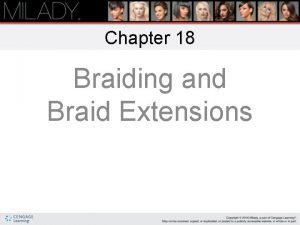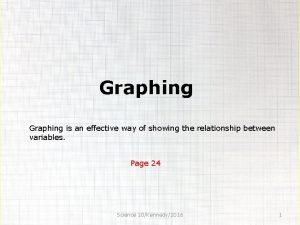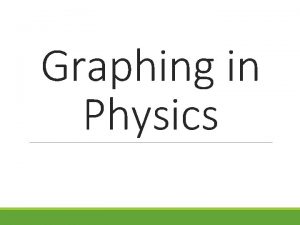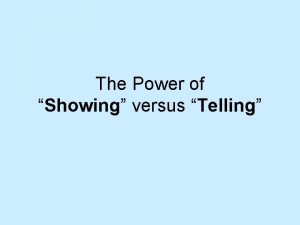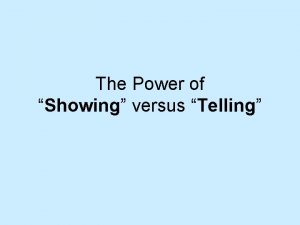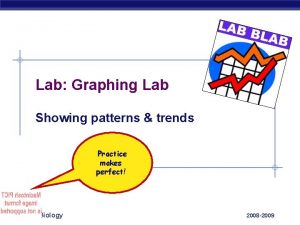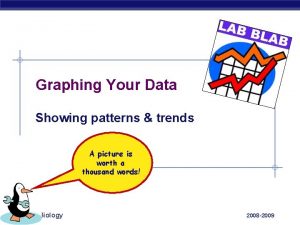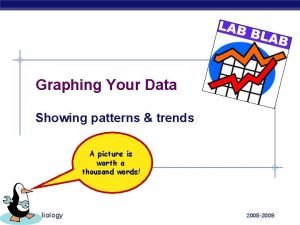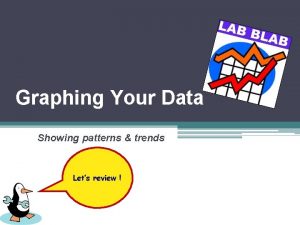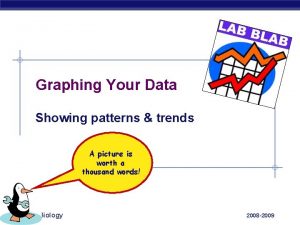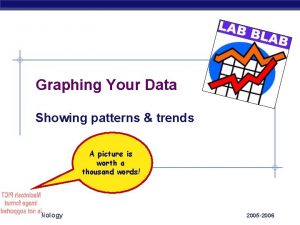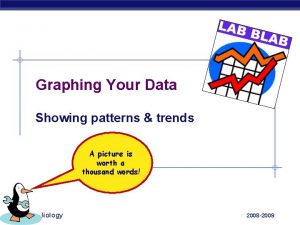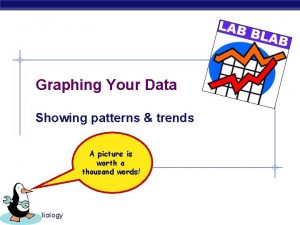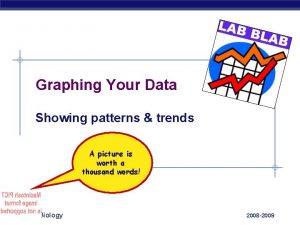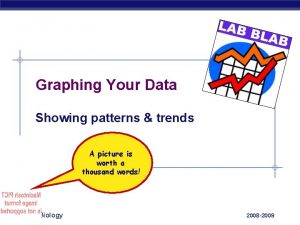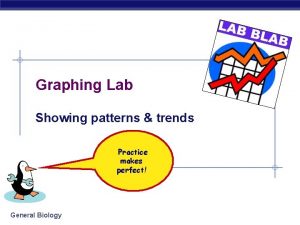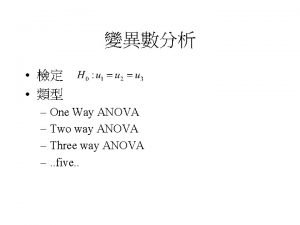Graphing is an effective way of showing the

























- Slides: 25

Graphing is an effective way of showing the relationship between variables. Page 11 Physics 20/Kennedy/2015 1

Page 11 Use precision graph paper. The lines should be about a mm apart. Don’t use the less precise grid paper where the lines are about a cm apart. Good Poor Precision graph paper will provide better results Lines are further apart providing poorer precision Physics 20/Kennedy/2015 2

Page 11 Data Tables Manipulated Responding Distance (m) Time (s) 10. 0 1. 1 20. 0 2. 1 30. 0 2. 9 Units are placed in column header. Don’t put units with the numbers in chart Controlled variables are items that are not changed Physics 20/Kennedy/2015 3

Graphical Analysis Page 11 Graphs are used to communicate relationships – how one thing affects another. Step Step 1: 2: 3: 4: 5: 6: Select the Axes Select a Scale Plot the Data Draw the Best-fit Line Title (responding versus manipulated) Calculate slope Your graph should be neat and not cluttered. Physics 20/Kennedy/2015 4

Graphical Analysis Page 11 Graphs are used to communicate relationships – how one thing affects another. Step 1: Select the Axes Responding y Manipulated x Time is always on the x-axis Physics 20/Kennedy/2015 5

Step 2: Select a Scale Page 11 Bad Good 3. 0 2. 0 1. 0 The graph should take up at least 2/3 of the graph paper. Physics 20/Kennedy/2015 6

Page 11 Select whichever orientation works best for your graph. Portrait view Landscape view Physics 20/Kennedy/2015 7

Don’t crowd the axis. 6. 0 8. 0 1. 0 3. 0 2. 0 4. 0 5. 0 7. 0 9. 0 10. 0 15. 0 20. 0 25. 0 Poor Good Physics 20/Kennedy/2015 8

When drawing a graph have a: • clear, plastic ruler/straight edge. You need to be able to see the ruler to graph properly. • sharp pencil. Thin lines are more precise and produce better results. Whenever you have to draw a straight line, use a ruler/straight edge. Physics 20/Kennedy/2015 9

Step 3: Plot the Data Page 11 1. Place a dot at the data point 2. Circle the data point Physics 20/Kennedy/2015 10

Step 4: Draw the Best-fit Line Best-fit lines and data points A best fit line should try to get as close as possible to all the points. This will result in as many points above the line as are before the line. A best fit line results in a type of average Do not connect the dots! A good best fit line should: • Have as many dots as possible on the line. • Have as many dots above the line as below • All the dots as close as possible to the line Physics 20/Kennedy/2015 11

Best fit lines Connect the dots – bad! Best fit line – good Use a clear plastic straight edge for best results Physics 20/Kennedy/2015 12

When drawing the best fit line, lift your pencil so as not to draw over the data point Physics 20/Kennedy/2015 13

Lines Connect the dots – bad! Force through zero – bad! Connect first to last – bad! Best fit line – good! Physics 20/Kennedy/2015 14

Extrapolate and interpolate Page 15 Extrapolate is extending the line beyond available data Interpolate is drawing a line between available data Physics 20/Kennedy/2015 15

Stray data points If a data point does not line up well with the rest of the dots then you may reject it as bad data. Draw an x through it or a place a question mark beside it. 40. 0 Mass (g) 30. 0 20. 0 10 20 30 40 50 Volume (m. L) Physics 20/Kennedy/2015 16

Step 5: Title (responding versus manipulated) Example: Distance versus time Distance as a function of time Page 11 Mass of water as a function of Volume 40. 0 Mass (g) 30. 0 20. 0 10 20 30 40 50 Volume (m. L) Physics 20/Kennedy/2015 17

Step 6: Calculate Slope is a measure of steepness of a line and is usually represented by the symbol m. Slope is the same anywhere on the straight line. Physics 20/Kennedy/2015 18

Identify the line having the greater slope. A Steeper, therefore greater slope B Physics 20/Kennedy/2015 19

Negative slope y y Positive slope x x Undefined slope y y Zero slope x x Physics 20/Kennedy/2015 20

When calculating slope: Page 15 • Don’t use data points as slope points • Select two points that are relatively far apart. • Use your clear plastic ruler to carefully mark the two slope points Mass of water as a function of Volume 40. 0 38, 37. 5 Mass (g) 30. 0 20. 0 12. 0, 11. 6 10. 0 10 20 30 40 50 Volume (m. L) Physics 20/Kennedy/2015 21

Calculating Slope = rise run y 2 – y 1 x 2 – x 1 Physics 20/Kennedy/2015 Show all work: 1. formula 2. substitution with units 3. Answer to proper sig digs 22

Selecting and marking slope points: You may select points that are as easy to read (estimate) as possible but make sure your estimate is actually on the graph. • Don’t use the nearest intersection to your best fit line • Take more care and mark slope points on the line. Physics 20/Kennedy/2015 23

If your graph curves you can use a flexible ruler or free-hand the line Distance as a function of Time 4. 0 distance (m) 3. 0 2. 0 1. 0 2. 0 3. 0 time (s) Physics 20/Kennedy/2015 4. 0 5. 0 p. 15 #1 Do 24

the end Physics 20/Kennedy/2015 25
 Peer pressure refusal skills
Peer pressure refusal skills Partial view
Partial view Explain the use of the square paddle brush in braiding
Explain the use of the square paddle brush in braiding Talk this way
Talk this way Definition of threaded binary tree
Definition of threaded binary tree Contoh two way anova
Contoh two way anova Perbedaan one way dan two way anova
Perbedaan one way dan two way anova The old way and the new way
The old way and the new way Key club meaning
Key club meaning What does one way anova tell you
What does one way anova tell you One was a ship
One was a ship Two way anova
Two way anova One way anova vs two way anova
One way anova vs two way anova Sự nuôi và dạy con của hươu
Sự nuôi và dạy con của hươu điện thế nghỉ
điện thế nghỉ Biện pháp chống mỏi cơ
Biện pháp chống mỏi cơ Trời xanh đây là của chúng ta thể thơ
Trời xanh đây là của chúng ta thể thơ Chó sói
Chó sói Thiếu nhi thế giới liên hoan
Thiếu nhi thế giới liên hoan Phối cảnh
Phối cảnh Các châu lục và đại dương trên thế giới
Các châu lục và đại dương trên thế giới Một số thể thơ truyền thống
Một số thể thơ truyền thống Thế nào là hệ số cao nhất
Thế nào là hệ số cao nhất Hệ hô hấp
Hệ hô hấp Tư thế ngồi viết
Tư thế ngồi viết Số.nguyên tố
Số.nguyên tố


